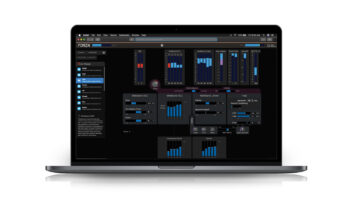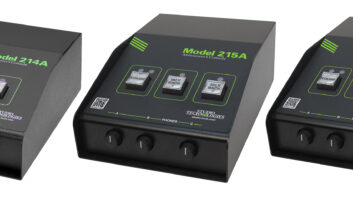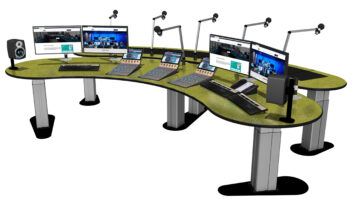
We use the Omnia 5EX and 6EX series processors at all of our stations here in Birmingham, both AM and FM, and love them. I was intrigued with the claim that the little Omnia One had “the sound” for a much lower price. The Studio Pro is the most recent addition to the Omnia One line. Other versions are optimized for AM, FM or DAB/Multicasting.
If you’re in a hurry, here’s the quick bottom line: the Omnia One is an amazingly versatile and good-sounding processor for under $3,000. It’s a real problem-solver and it’s cost-effective. Basically, anywhere you want “that sound,” but can’t justify spending the big bucks for a full-sized Omnia, this little fellow will fit the bill.
Installation
The Omnia One Studio Pro, like its siblings, fits in a single rack space, though the manual recommends that you leave the slots above and below open for ventilation. The unit is relatively light and is only 16 inches deep, so it’s not difficult to find a good spot for it. It is well-shielded, with EMI/RF filtering on all inputs (including the AC supply), but the usual warnings still apply: Don’t mount it over a big transformer and do plug it into a good UPS.
The unit feels nice and solid. There are only two front-panel controls, one for headphone volume and a jog wheel for configuration. The blue-monochrome LCD display is a little difficult to read more than a few feet from the unit, but it’s fine for basic configuration and monitoring. There’s also an LED level meter in the front panel that can be assigned to either input or output and which is visible from across a room.
So where does this processor fit? Larger units such as the 5EX and 6EX offer more control over every aspect of processing. They can also be used to provide simultaneous, separately-limited outputs with diversity delay for HD Radio. The Omnia One, by contrast, is an all-purpose box that can assume specific personalities (what Omnia calls ‘styles’) by simply loading different software. As the product brochure says, depending on the “styles” loaded, it can be used for AM, FM, HD-R, netcasting, multicasting, podcasting, or “any other form of ‘-casting’ you can think of.”
(click thumbnail)
As of this writing, software for AM, FM, studio and multicasting (which covers all digital “streaming” or “-casting” applications) is available for download at no charge from Omnia’s Web site. Another nice touch is that there are two software banks so each can be set up in advance with different styles and then selected on the fly.
To support this approach, the One has plenty of gazintas and gazoutas on the back panel. There are analog ins and outs, AES ins and outs (via StudioHub+ RJ-45 connectors) and a Livewire/Ethernet connection. Analog and digital outputs can be used simultaneously, with separate level adjustments for each (nice!). BNC connectors are provided for composite and SCA I/O. There’s even an SCA insertion adjustment on the rear — a pleasant surprise for a unit of this size.
I received the Omnia One Studio Pro “style” for this test. The BNC connectors aren’t used, limiting is softer and there’s no pre-emphasis or de-emphasis. As the name implies, this is ideal for studio use: gain-riding, post-production, headphone limiting and remote feed control. A key feature for this style is very low delay in throughput (the manual specifies less than 4.3 milliseconds, worst-case, input to output). This is ideal for creating a fake air monitor signal, providing a processed sound to air talent when they’re unable to directly monitor the transmitter because of an HD-R or profanity delay.
For my test, I chose the analog inputs and outputs because I wanted to hear the “longest” path through the unit, with worst-case throughput delay, from A/D at the input to D/A at the output. Omnia states that Crystal Semiconductor 24-bit, 128x oversampled conversion chips are used. In my listening tests, the unit certainly sounded transparent and the delay was inaudible.
One warning: the Omnia One Studio Pro requires quite a bit of time to boot up. It takes 10 to 15 seconds before you hear audio and up to a minute to get a usable LCD display and jog wheel. Aside from the possibility of damage or data corruption from a power glitch, then, I really do recommend that you put this unit on a quality UPS. Noisy AC with dropouts will render it unusable.
Operation
(click thumbnail)
Fig. 1: Screenshot from Remote Software I started at the front panel with the jog wheel. If you’ve used an Omnia, you’ll feel right at home with it: You turn left or right to select different menu items, then press to make a selection. The jog wheel feels good, with a positive “click.” All processing configuration can be done via the front panel; you can select presets, edit the parameters and save your current settings under a new preset name.
Of course, it’s easier and more intuitive to adjust the unit via the built-in Web interface. As instructed in the manual, I used the front-panel jog wheel to set up my IP address, netmask and gateway. Once done, I simply entered the IP address in Firefox under openSUSE Linux and it worked perfectly. I was happy to note this; while built-in Web browsers have become more common nowadays, many manufacturers apparently haven’t gotten the message yet. They want to tie us to Windows-only software. Fig. 1 shows me tweaking the high-band limiting.
Now for the important question: How does it sound?
Remember that the Studio Pro style is intended for gain riding and in-house processing; it doesn’t have the aggressive peak limiting that’s required for positive modulation control. I judged it with that in mind. I started with the basic “General” preset, as recommended by the manual. The unit was virtually transparent with this preset, acting like a smooth and skilled operator riding a gain control.
I then switched to the “Aggressive” preset … and started grinning. “Hey, that’s an Omnia!” The signature sound was there: tight bass and sizzling highs. I tried this preset with several different formats, from Christian contemporary through AC/oldies to talk, and it sounded great with all of them. This particular preset will work out of the box for fake air monitoring, as mentioned above. You might want to tone it down a bit or use a “General” preset for production work, though.
I’m an incorrigible tweaker, so I used the remote interface to fiddle with the presets. By shortening the attack and release times and by increasing the drive at certain points in the processing chain, I was able to make this thing obnoxiously loud. Aside from the usual artifacts to be expected with very heavy processing — “shimmering” cymbals and occasional, outright ducking on some program material — it remained clean and clear overall.
Documentation



Telos/Omnia is known for producing some of the best user manuals in the industry. The manual is quite adequate. Once you’ve got the network set up and have connected to the unit with your Web browser, you might want to skip to Chapter 3, “Getting the Sound You Want.”
Using the remote interface and a set of speakers, you can start with one of the factory presets and make minor adjustments until you get what you want. As with all Omnia products, a relatively small tweak (a half of a decibel, in some cases) can make a dramatic difference in the final sound, especially changes made before limiting. With the remote interface, you can save work in progress, go back to an earlier setup if you get lost, and finally, rename and save your customized preset when you are satisfied.
The suggested list price is $2,995, and many dealers sell it for substantially less than that. This makes the Omnia One Studio Pro an ideal way for a small-market station to get “that sound” on a budget. The Omnia One Studio Pro even has some of the trademark features of the larger units, such as “phat bass,” which improves sound in portables with less-than-optimum speakers. Simply put, the One lives up to the legacy.
Suggested uses include use as a standby processor. Given its flexibility, it is cheap insurance for an AM/FM cluster. One bank could be loaded with the AM style and the other with FM. If any station should lose its main processor, the Omnia One Studio Pro could be substituted quickly during the repair.
Another use could be as a fake air monitor, as mentioned. One simple arrangement would involve the Omnia One SP with a relay that would switch open if the transmitter should go off air. You’d feed the studio’s headphones and monitor speakers through the relay.
Of course, the Omnia One Studio Pro can ride levels wherever needed. It is inexpensive enough that many stations might consider using it to level remote and satellite feeds, or to pre-process an STL signal. It brings true, top-quality, all-digital multiband processing well within even the tightest budget.
To me, for the price, the best feature of the Omnia One Studio Pro is its flexibility. By loading different software “styles,” you can literally transform the One from an AM to an FM processor, and then from FM to podcasting, all on the fly. The remote interface allows you to save all sorts of presets, even across styles. I strongly recommend it as a cost-effective, top-quality broadcast audio processor.
Stephen M. Poole, CBRE-AMD, CBNT is market chief engineer for the Crawford Broadcasting Company’s five-station AM/FM cluster in Birmingham, Ala. He has more than 30 years of experience with twirling knobs and making radio sound as good as it can.












